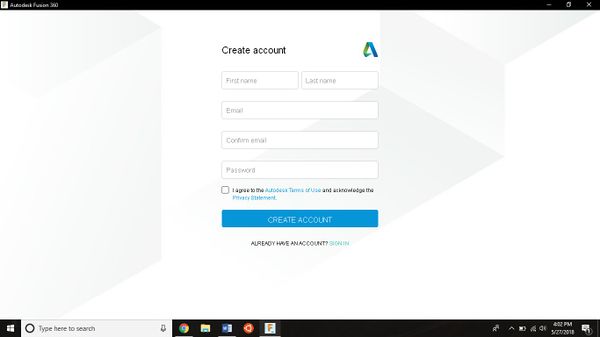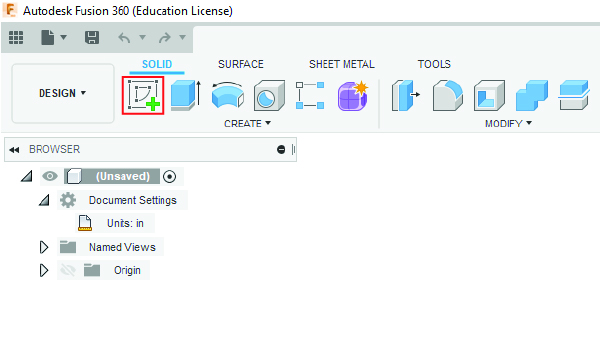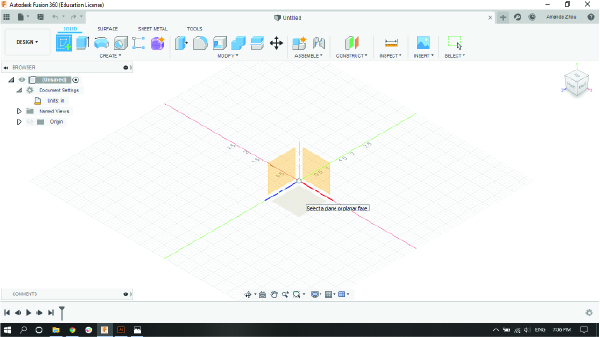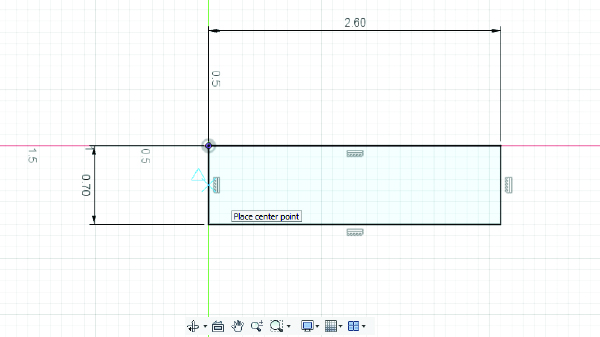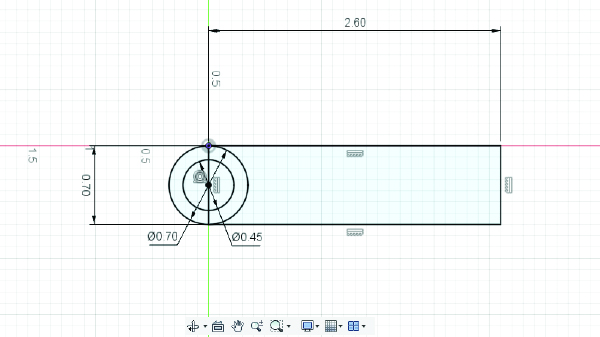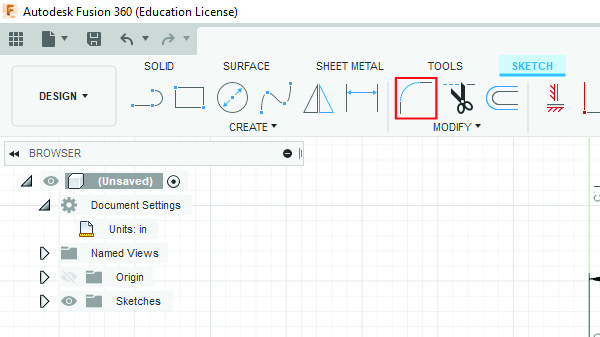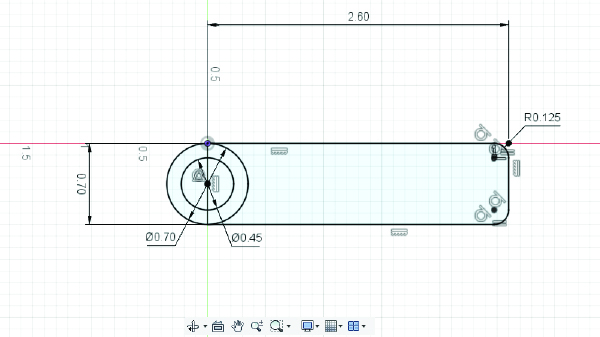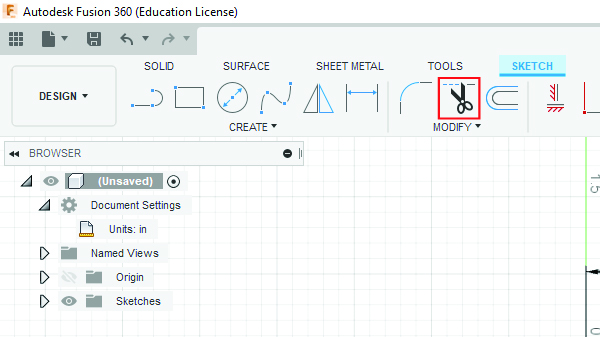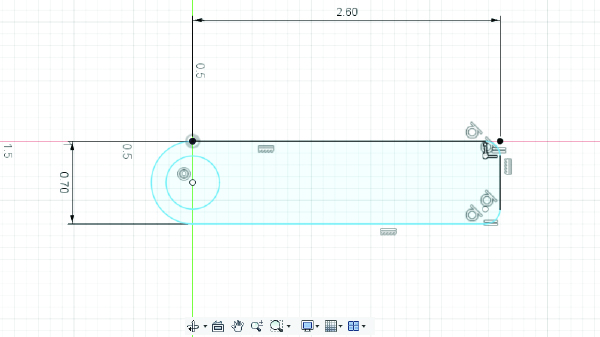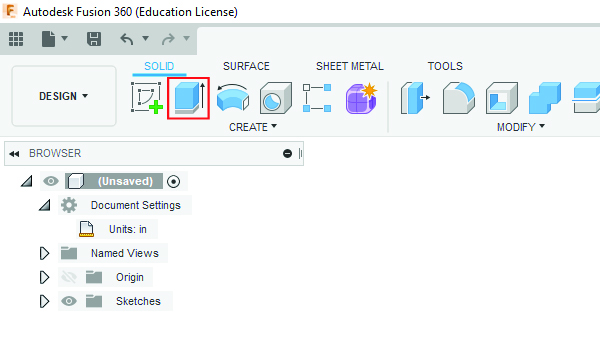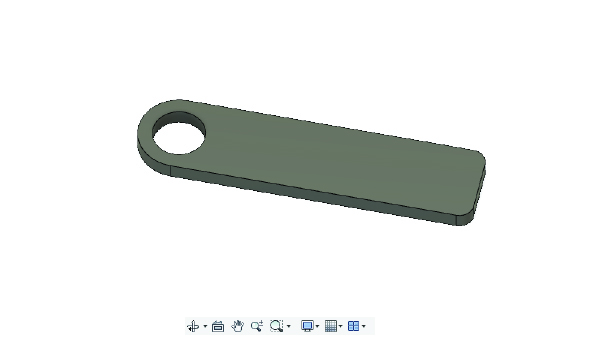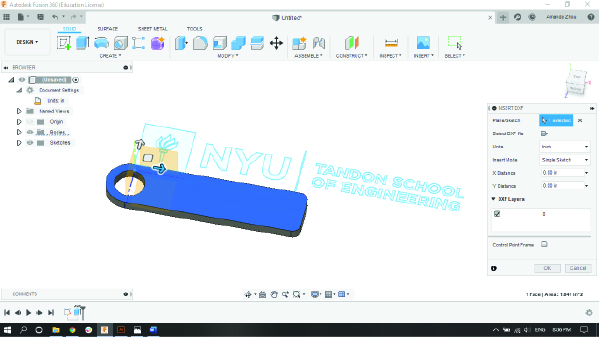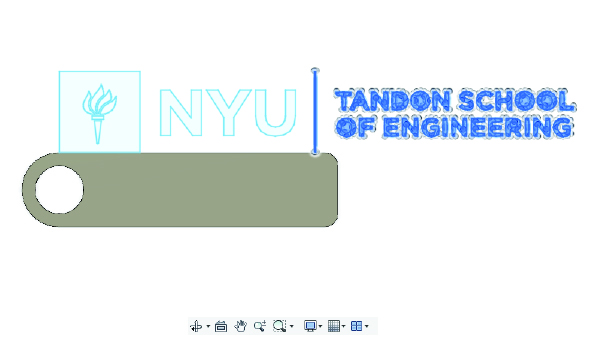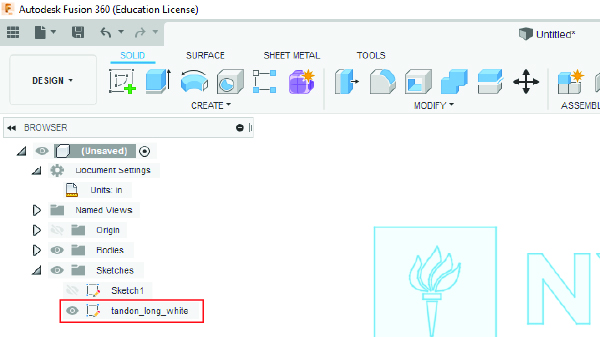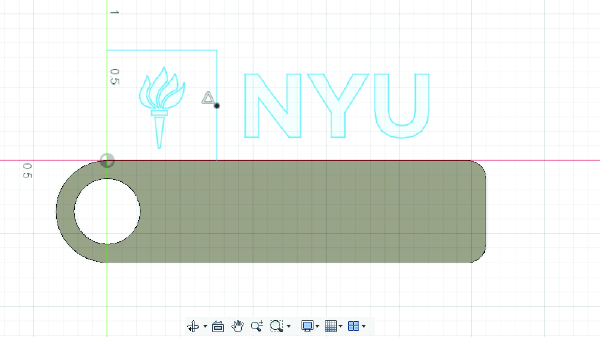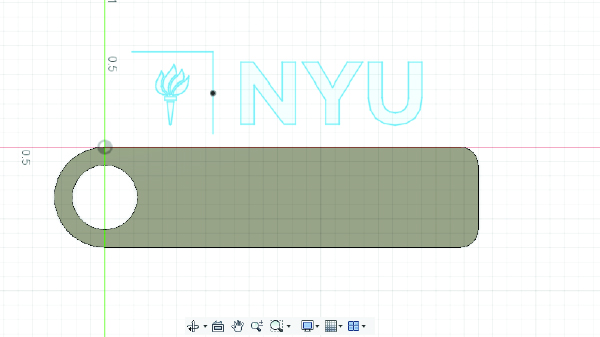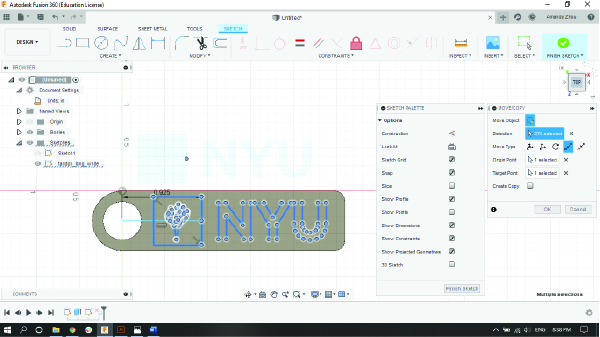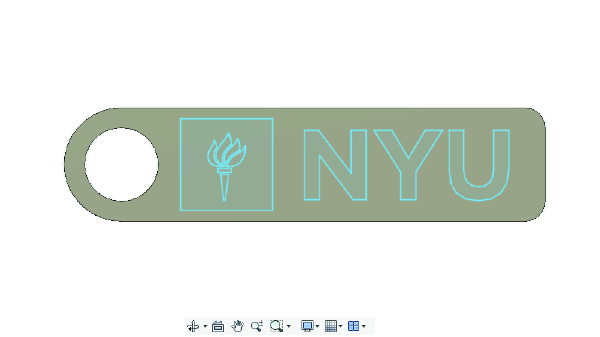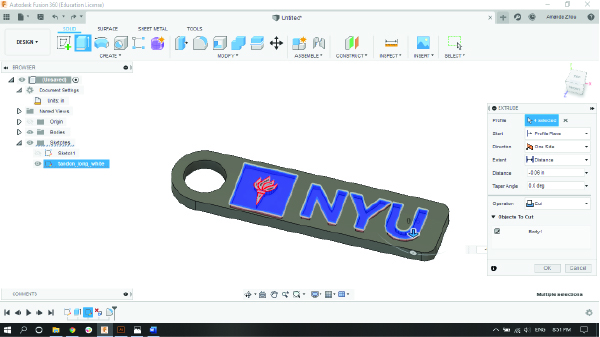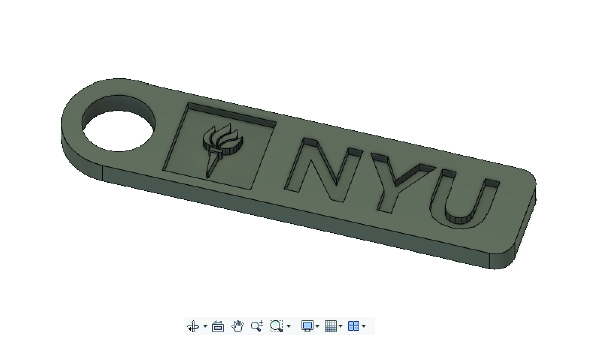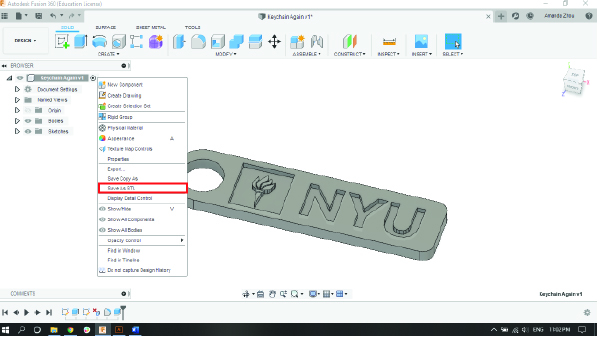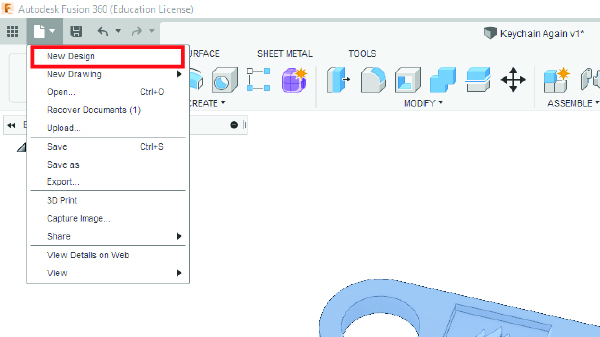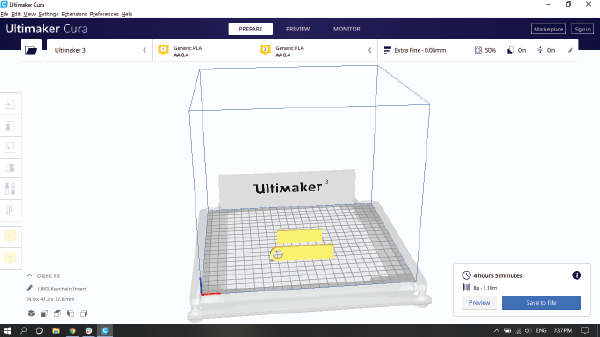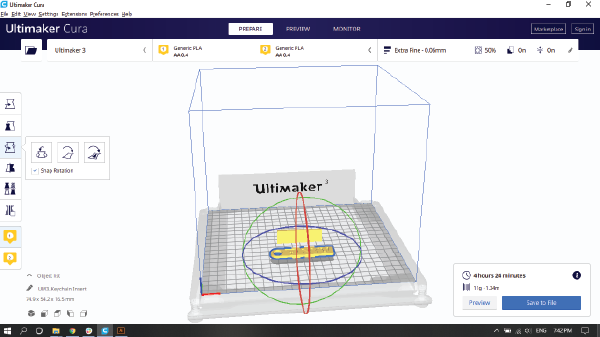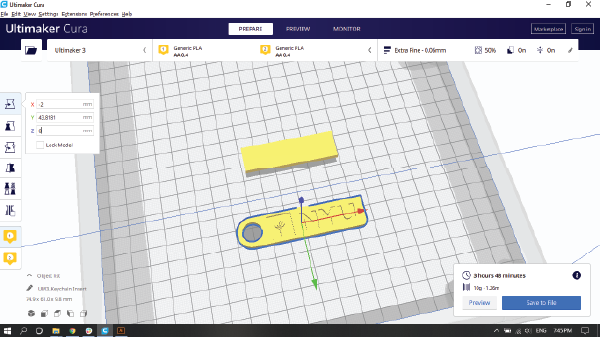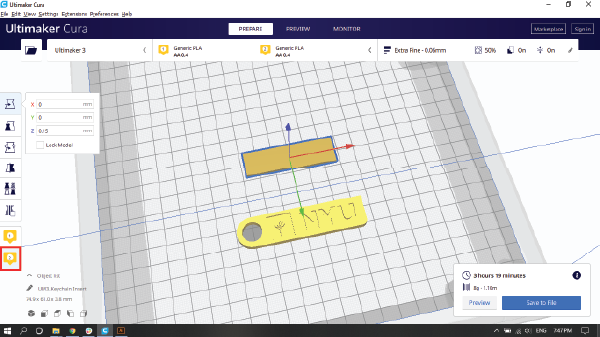Difference between revisions of "Introduction to Revit"
| Line 30: | Line 30: | ||
# Fillet (round) the corners of the base. Select the Fillet tool from the Modify section of the toolbar (Figure 7). [[Image:Lab 1B7.jpg|thumb|center|600px|Figure 7: Fillet Tool]] | # Fillet (round) the corners of the base. Select the Fillet tool from the Modify section of the toolbar (Figure 7). [[Image:Lab 1B7.jpg|thumb|center|600px|Figure 7: Fillet Tool]] | ||
# Select one of the two intersecting lines that form the right angles on the base. Set the fillet radius to 0.125" and repeat on the other corner. The sketch should look like Figure 8. [[Image:Lab 1B8.jpg|thumb|center|600px|Figure 8: Filleted Corners]] | # Select one of the two intersecting lines that form the right angles on the base. Set the fillet radius to 0.125" and repeat on the other corner. The sketch should look like Figure 8. [[Image:Lab 1B8.jpg|thumb|center|600px|Figure 8: Filleted Corners]] | ||
# Remove the extra lines using the trim tool. Select the trim tool from the Modify section of the toolbar. [[Image: Trim Tool.jpg|thumb|center|600px|Figure | # Remove the extra lines using the trim tool. Select the trim tool from the Modify section of the toolbar. [[Image: Trim Tool.jpg|thumb|center|600px|Figure 9: Trim Tool]] | ||
# Select all interior lines that divide the keychain to trim them. If error messages are indicated, remove the dimensions on the rest of the keychain by clicking on them and pressing the Delete key. The sketch should look like Figure | # Select all interior lines that divide the keychain to trim them. If error messages are indicated, remove the dimensions on the rest of the keychain by clicking on them and pressing the Delete key. The sketch should look like Figure 10. [[Image:Lab 1B9.jpg|thumb|center|600px|Figure 10: Keychain Base]] | ||
# Exit the sketch using the Finish Sketch button in the top right of the window. | # Exit the sketch using the Finish Sketch button in the top right of the window. | ||
# After creating a 2D sketch, the next step is to use that sketch to create a 3D object. The Extrude tool will be used to create a 3D block. In the future, the Revolve or other tools can be used to create more advanced geometry. Select the Extrude tool from the Create section of the toolbar (Figure | # After creating a 2D sketch, the next step is to use that sketch to create a 3D object. The Extrude tool will be used to create a 3D block. In the future, the Revolve or other tools can be used to create more advanced geometry. Select the Extrude tool from the Create section of the toolbar (Figure 11).</li>[[Image:Lab 1B10 V2.jpg|thumb|center|600px|Figure 11: Extrude Tool]] | ||
# The Extrude information dialog will pop-up on the right side of the window. First, select the profile of the object to be extruded, which is the sketch that was just created. The sketch will highlight blue if it was made correctly. Click and change the extrusion thickness to 0.15" and press the Enter key. Click OK in the Extrude information dialog. The model will look like Figure | # The Extrude information dialog will pop-up on the right side of the window. First, select the profile of the object to be extruded, which is the sketch that was just created. The sketch will highlight blue if it was made correctly. Click and change the extrusion thickness to 0.15" and press the Enter key. Click OK in the Extrude information dialog. The model will look like Figure 12. [[Image:Lab 1B11.jpg|thumb|center|600px|Figure 12: Extruded Sketch]] | ||
# The next step is to add the design to the keychain. A vector graphics file will be used in the DXF format provided by NYU. In the future, a logo can be designed using the sketch tool. Download the [[Media:Tandon_long_white.zip|Tandon Logo DXF File]] (this logo was converted from the file provided on NYU's identity page). | # The next step is to add the design to the keychain. A vector graphics file will be used in the DXF format provided by NYU. In the future, a logo can be designed using the sketch tool. Download the [[Media:Tandon_long_white.zip|Tandon Logo DXF File]] (this logo was converted from the file provided on NYU's identity page). | ||
# The downloaded ZIP folder must first be extracted. Then, select Insert DXF under the Insert section of the toolbar (Figure | # The downloaded ZIP folder must first be extracted. Then, select Insert DXF under the Insert section of the toolbar (Figure 13). [[Image:Lab 1B12.jpg|thumb|center|600px|Figure 13: Insert DXF Tool]] | ||
# The Insert DXF information dialog will appear on the right side of the window. For the Plane/Sketch, select the top surface of the keychain (Figure | # The Insert DXF information dialog will appear on the right side of the window. For the Plane/Sketch, select the top surface of the keychain (Figure 14). [[Image:Lab 1B13.jpg|thumb|center|600px|Figure 14: Selected Top Surface]] | ||
# Click the folder icon next to Select DXF file to upload the Tandon Logo DXF File. The logo should appear (Figure | # Click the folder icon next to Select DXF file to upload the Tandon Logo DXF File. The logo should appear (Figure 15). [[Image:Lab 1B14.jpg|thumb|center|600px|Figure 15: Imported DXF Logo]] | ||
# Change the units to inches and click OK. | # Change the units to inches and click OK. | ||
# The vertical bar and Tandon School of Engineering portions of the logo are not needed. Select the bar and text to the right by clicking and dragging (Figure | # The vertical bar and Tandon School of Engineering portions of the logo are not needed. Select the bar and text to the right by clicking and dragging (Figure 16).[[Image:Lab 1B15.jpg|thumb|center|600px|Figure 16: Tandon to Delete]] | ||
# Delete this portion with the Delete key on the keyboard (not Backspace). | # Delete this portion with the Delete key on the keyboard (not Backspace). | ||
# The logo needs to be scaled to fit the keychain. A base point must be selected for which the sketch will be scaled to. The midpoint of the line on the right side of the box around the torch will be used as the base point, so a point must be placed there first. | # The logo needs to be scaled to fit the keychain. A base point must be selected for which the sketch will be scaled to. The midpoint of the line on the right side of the box around the torch will be used as the base point, so a point must be placed there first. | ||
# To place a point, the sketch must be in editing mode. A sketch is known to be in editing mode when the background turns into gridlines and Finish Sketch appears at the top right of the window. Enter the tandon_long_white sketch by double clicking on the sketch name in the Browser. [[Image:Browser.jpg|thumb|center|600px|Figure | # To place a point, the sketch must be in editing mode. A sketch is known to be in editing mode when the background turns into gridlines and Finish Sketch appears at the top right of the window. Enter the tandon_long_white sketch by double clicking on the sketch name in the Browser. [[Image:Browser.jpg|thumb|center|600px|Figure 17: Sketches in Browser]] | ||
# Select the Point tool under the Create section of the toolbar. Place a point at the midpoint of the right side of the box around the torch (Figure | # Select the Point tool under the Create section of the toolbar. Place a point at the midpoint of the right side of the box around the torch (Figure 18). [[Image:Lab 1B17.jpg|thumb|center|600px|Figure 18: Midpoint on Box]] | ||
# Delete the bottom and the left side of the box around the torch. (Figure | # Delete the bottom and the left side of the box around the torch. (Figure 19)[[Image:Lab 1B18 V2.jpg|thumb|center|600px|Figure 19: Partly Deleted Box]] | ||
# Select the Sketch Scale tool from the Modify section of the toolbar. The Sketch Scale information dialog will appear on the right side of the window. For the Entities, select the remaining lines of the box and torch of the logo by clicking and dragging. <b> Make sure to not select the midpoint that was just placed on the right side of the box </b>. | # Select the Sketch Scale tool from the Modify section of the toolbar. The Sketch Scale information dialog will appear on the right side of the window. For the Entities, select the remaining lines of the box and torch of the logo by clicking and dragging. <b> Make sure to not select the midpoint that was just placed on the right side of the box </b>. | ||
# Select the midpoint that was just placed as the Point for scaling. | # Select the midpoint that was just placed as the Point for scaling. | ||
# Enter a scaling factor of 0.75 and click OK. (Figure | # Enter a scaling factor of 0.75 and click OK. (Figure 20) [[Image:Lab 1B19.jpg|thumb|center|600px|Figure 20: Scaled Box]] | ||
# Redraw the two sides of the box that were deleted using the Line tool in the Create section of the toolbar (Figure | # Redraw the two sides of the box that were deleted using the Line tool in the Create section of the toolbar (Figure 21). [[Image:Lab 1B20.jpg|thumb|center|600px|Figure 21: Redrawn Box]] | ||
# The logo must now be positioned on the keychain. This will be done by drawing a line for alignment and moving the logo design to where the alignment line is located. Select the line tool and draw a 0.925" horizontal line from a point close to the center of the hole in the keychain base to the right (Figure | # The logo must now be positioned on the keychain. This will be done by drawing a line for alignment and moving the logo design to where the alignment line is located. Select the line tool and draw a 0.925" horizontal line from a point close to the center of the hole in the keychain base to the right (Figure 22). [[Image:Lab 1B21.jpg|thumb|center|600px|Figure 22: Alignment Line]] | ||
# Select the entire logo by clicking and dragging. Then select Move/Copy under the Modify section of the toolbar. | # Select the entire logo by clicking and dragging. Then select Move/Copy under the Modify section of the toolbar. | ||
# The Move/Copy information dialog will appear on the right side of the window. The Selection should already be made (the NYU logo). Select Point to Point as the Move Type. For the Origin Point, select the midpoint from the side of the box around the torch. For the Target Point, select the right end of the alignment line that was previously drawn (Figure | # The Move/Copy information dialog will appear on the right side of the window. The Selection should already be made (the NYU logo). Select Point to Point as the Move Type. For the Origin Point, select the midpoint from the side of the box around the torch. For the Target Point, select the right end of the alignment line that was previously drawn (Figure 23). Click OK. [[Image:Lab 1B22.jpg|thumb|center|600px|Figure 23: Move/Copy Tool]] | ||
# Delete the alignment line that was previously drawn. | # Delete the alignment line that was previously drawn. | ||
# Click Finish Sketch in the top right of the window to exit the sketch. The final sketch is shown in Figure | # Click Finish Sketch in the top right of the window to exit the sketch. The final sketch is shown in Figure 24. [[Image:Lab 1B23.jpg|thumb|center|600px|Figure 24: Final Sketch]] | ||
# To finish this side of the keychain, the design must be cut into the base. To do this, the Extrude tool will be used. | # To finish this side of the keychain, the design must be cut into the base. To do this, the Extrude tool will be used. | ||
# To cut the design, select Extrude from the Create section of the toolbar. The Extrude information dialog will appear on the right side of the window. Select the Profile of the design to cut, which is the area around the torch and each of the letters (Figure | # To cut the design, select Extrude from the Create section of the toolbar. The Extrude information dialog will appear on the right side of the window. Select the Profile of the design to cut, which is the area around the torch and each of the letters (Figure 25). [[Image:Lab 1B24.jpg|thumb|center|600px|Figure 25: Selected Cut Profile]] | ||
# For the Operation, select Cut. Set the Distance to -0.06" (Figure | # For the Operation, select Cut. Set the Distance to -0.06" (Figure 26). Click OK.[[Image:Lab 1B25.jpg|thumb|center|600px|Figure 26: Cut Tool]] | ||
# The final model is shown in Figure | # The final model is shown in Figure 27. [[Image:Lab 1B26.jpg|thumb|center|600px|Figure 27: Final Model]] | ||
== 3. Export for Printing == | == 3. Export for Printing == | ||
| Line 64: | Line 64: | ||
# Cura only reads 3D files in millimeters, so your model must be converted to millimeters. In the Browser on the left side of the window, go under Document Settings and change the units to millimeters. <b>Do not</b> set millimeters as the default (default units should be inches). | # Cura only reads 3D files in millimeters, so your model must be converted to millimeters. In the Browser on the left side of the window, go under Document Settings and change the units to millimeters. <b>Do not</b> set millimeters as the default (default units should be inches). | ||
# Right click the Activate Component icon (white circle with a black dot) in the Browser and select Save as STL (Figure | # Right click the Activate Component icon (white circle with a black dot) in the Browser and select Save as STL (Figure 28). [[Image:Lab 1B27.jpg|thumb|center|600px|Figure 28: Save Work]] | ||
# The Save As STL information dialog will appear on the right side of the window. Click OK - no need to change any of the settings. | # The Save As STL information dialog will appear on the right side of the window. Click OK - no need to change any of the settings. | ||
# Save the file to a location that is easily remembered. | # Save the file to a location that is easily remembered. | ||
| Line 70: | Line 70: | ||
== 4. Designing the Keychain Insert == | == 4. Designing the Keychain Insert == | ||
The last step of the keychain design is to make the keychain insert that will fit in the center of the keychain base to make the NYU logo white. | The last step of the keychain design is to make the keychain insert that will fit in the center of the keychain base to make the NYU logo white. | ||
# Click File > New Design in the toolbar at the top of the screen (Figure | # Click File > New Design in the toolbar at the top of the screen (Figure 29). [[Image:Lab 1B28.jpg|thumb|center|600px|Figure 29: Start New Design]] | ||
# Make sure the document settings are in inches. | # Make sure the document settings are in inches. | ||
# Start a 2D sketch on the XZ plane and sketch a 2.2" × 0.65" rectangle at the origin. Exit the sketch. | # Start a 2D sketch on the XZ plane and sketch a 2.2" × 0.65" rectangle at the origin. Exit the sketch. | ||
# Extrude the rectangle 0.12”. | # Extrude the rectangle 0.12”. | ||
# The final model is shown in Figure | # The final model is shown in Figure 30. [[Image:Lab 1B29.jpg|thumb|center|600px|Figure 30: Keychain Insert]] | ||
# Save and export the keychain insert as described in “3. Export for Printing.” | # Save and export the keychain insert as described in “3. Export for Printing.” | ||
| Line 81: | Line 81: | ||
# Open Cura. If a menu pops up prompting for the printer, select the Ultimaker 3. If a menu does not pop up, make sure the printer currently selected is Ultimaker 3 at the top left corner. | # Open Cura. If a menu pops up prompting for the printer, select the Ultimaker 3. If a menu does not pop up, make sure the printer currently selected is Ultimaker 3 at the top left corner. | ||
# To load the two files from above, select File > Open File(s) at the top left of the window and open the STL files containing the base of the keychain and the keychain insert (Figure | # To load the two files from above, select File > Open File(s) at the top left of the window and open the STL files containing the base of the keychain and the keychain insert (Figure 31). | ||
# In Cura, right click and drag to pan around, middle click and drag to move your frame of view, and scroll up and down to zoom in and out. [[Image:Lab1B30V2.png|thumb|center|600px|Figure | # In Cura, right click and drag to pan around, middle click and drag to move your frame of view, and scroll up and down to zoom in and out. [[Image:Lab1B30V2.png|thumb|center|600px|Figure 32: STL Files Loaded in Cura]] | ||
# Select the keychain base and click the Rotate tool from the toolbar on the left side of the window. Use the red, blue, and green hoops to rotate the base so that the logo design is facing upward (Figure | # Select the keychain base and click the Rotate tool from the toolbar on the left side of the window. Use the red, blue, and green hoops to rotate the base so that the logo design is facing upward (Figure 33). Do the same for the keychain filler. Uncheck the Snap Rotation option for more precise rotation. [[Image:Lab1B31V2.png|thumb|center|600px|Figure 33: Rotate Hoops]] | ||
<!--# By default, Cura does not allow objects to overlap. However, this must be done to place the insert inside the keychain base. To change this default setting, go to Preferences and select Configure Cura. | <!--# By default, Cura does not allow objects to overlap. However, this must be done to place the insert inside the keychain base. To change this default setting, go to Preferences and select Configure Cura. | ||
# Under Viewport behavior in the General tab, make sure to deselect both “Ensure models are kept apart” and “Automatically drop models to the build plate” if they are not already deselected (Figure | # Under Viewport behavior in the General tab, make sure to deselect both “Ensure models are kept apart” and “Automatically drop models to the build plate” if they are not already deselected (Figure 34). Click Close. [[Image:Lab1B32.png|thumb|center|600px|Figure 34: Cura Preferences]]--> | ||
# Make sure both objects are lying flat on the buildplate by using Rotate > Lay Flat. If the Lay Flat tool does not lay the object flat, go to the Move tool and type in 0 mm for the Z value (Figure | # Make sure both objects are lying flat on the buildplate by using Rotate > Lay Flat. If the Lay Flat tool does not lay the object flat, go to the Move tool and type in 0 mm for the Z value (Figure 35). [[Image:Lab1B33V2.png|thumb|center|600px|Figure 35: Move Tool]] | ||
# Select the rectangle insert, and using the Move tool on the left, enter 0.15 mm as the Z value to raise it vertically. | # Select the rectangle insert, and using the Move tool on the left, enter 0.15 mm as the Z value to raise it vertically. | ||
# Select the keychain insert and set it under Extruder 2 in the toolbar on the left (Figure | # Select the keychain insert and set it under Extruder 2 in the toolbar on the left (Figure 36). That piece will appear as slightly darker yellow. The insert must be set under a different extruder because it will be printed in a different color than the keychain base. [[Image:Lab1B34V2.png|thumb|center|600px|Figure 36: Changing Extruders]] | ||
# Having the keychain insert selected, select the Move tool on the left-hand toolbar. Using the red and green arrows, drag the insert piece and align it in the keychain base (Figure | # Having the keychain insert selected, select the Move tool on the left-hand toolbar. Using the red and green arrows, drag the insert piece and align it in the keychain base (Figure 37). Make sure not to move the insert piece in the Z direction as this was previously set in Step 8. [[Image:Lab1B35V2.png|thumb|center|600px|Figure 37: Final Cura Setup]] | ||
# Click Save to File in the bottom right of the window. Save the file as a GCODE file. Upload it to the EG1003 website. | # Click Save to File in the bottom right of the window. Save the file as a GCODE file. Upload it to the EG1003 website. | ||
Revision as of 12:10, 1 September 2020
Objective
This exercise will introduce Autodesk Fusion 360, which is a drafting software that is used by technical professionals, and basic technical design methods will be shown using this computer-aided design (CAD) software. This software will be used in the semester-long design project (SLDP) by constructing physical prototypes with 3D printing. To practice this prototyping procedure, an NYU logo keychain will be created in Autodesk Fusion 360 and prepared in Cura to be 3D printed.
Overview
Computer-Aided Design
CAD programs, which include Autodesk's Fusion 360, AutoCAD, and Revit; Dassault Systèmes SolidWorks; and Google SketchUp, allow engineers to make dimensioned, scaled drawings. These drawings are used to manufacture equipment, build infrastructure, and allow designers to display their designs with complete specifications and detail. Orthographic views (top, bottom, side, front, back) can be used to document the technical specifications in drawings needed for production while axonometric views (isometric, dimetric, trimetric) can be used to view the final 3D representation of a product.
This exercise will teach the basics of Autodesk Fusion 360, 3D file formats, the basics of 3D printing, and the skills needed to create simple 3D files and prepare them to be 3D printed.
3D Printing
3D printing allows rapid prototyping and onsite manufacturing of products. Initially done with plastic, 3D printing now uses new techniques with new materials, such as aluminum, bronze, and glass. Biomaterials are also being used, such as 3D printing ear cartilage and liver tissue. As the 3D printing industry grows, 3D printing has become a significant part of many engineering fields.
In this course, 3D printing can be used to produce prototype components, building models, SLDP course modifications, robot parts, and a company logo.
Procedure
1. Setting up the File
- Launch AutoDesk Fusion 360, click Create Account, and fill in the information. Important: Make sure to use an NYU email (Figure 1).
2. Designing the NYU Keychain
- First, ensure that the units of your drawing are in inches. They are in the Browser on the left side of the window under Document Settings.
- Start a 2D Sketch by clicking Create Sketch (Figure 2).
- Select the XZ plane (Figure 3).
- Select the 2-Point Rectangle from the Sketch section of the toolbar (Figure 4).
- Draw a 2.6” × 0.7” rectangle starting at the origin. Click once at the origin to place one point of the rectangle and click one more time to place the second point of the rectangle. The length values can be typed in before placing the second point of the rectangle (switching which value is changed is done using the Tab key).
- Select the Center Diameter Circle from the Sketch section of the toolbar.
- Draw a 0.7” diameter circle centered in the middle of one of the 0.7" sides of the rectangle (the cursor should become a blue X with a triangle and snap to the midpoint of the line when you get close) (Figure 5). Similar to the 2-Point Rectangle, the diameter of the circle can by typed.
- Draw another circle 0.45” in diameter in the same position. The sketch should look like Figure 6.
- Fillet (round) the corners of the base. Select the Fillet tool from the Modify section of the toolbar (Figure 7).
- Select one of the two intersecting lines that form the right angles on the base. Set the fillet radius to 0.125" and repeat on the other corner. The sketch should look like Figure 8.
- Remove the extra lines using the trim tool. Select the trim tool from the Modify section of the toolbar.
- Select all interior lines that divide the keychain to trim them. If error messages are indicated, remove the dimensions on the rest of the keychain by clicking on them and pressing the Delete key. The sketch should look like Figure 10.
- Exit the sketch using the Finish Sketch button in the top right of the window.
- After creating a 2D sketch, the next step is to use that sketch to create a 3D object. The Extrude tool will be used to create a 3D block. In the future, the Revolve or other tools can be used to create more advanced geometry. Select the Extrude tool from the Create section of the toolbar (Figure 11).
- The Extrude information dialog will pop-up on the right side of the window. First, select the profile of the object to be extruded, which is the sketch that was just created. The sketch will highlight blue if it was made correctly. Click and change the extrusion thickness to 0.15" and press the Enter key. Click OK in the Extrude information dialog. The model will look like Figure 12.
- The next step is to add the design to the keychain. A vector graphics file will be used in the DXF format provided by NYU. In the future, a logo can be designed using the sketch tool. Download the Tandon Logo DXF File (this logo was converted from the file provided on NYU's identity page).
- The downloaded ZIP folder must first be extracted. Then, select Insert DXF under the Insert section of the toolbar (Figure 13).
- The Insert DXF information dialog will appear on the right side of the window. For the Plane/Sketch, select the top surface of the keychain (Figure 14).
- Click the folder icon next to Select DXF file to upload the Tandon Logo DXF File. The logo should appear (Figure 15).
- Change the units to inches and click OK.
- The vertical bar and Tandon School of Engineering portions of the logo are not needed. Select the bar and text to the right by clicking and dragging (Figure 16).
- Delete this portion with the Delete key on the keyboard (not Backspace).
- The logo needs to be scaled to fit the keychain. A base point must be selected for which the sketch will be scaled to. The midpoint of the line on the right side of the box around the torch will be used as the base point, so a point must be placed there first.
- To place a point, the sketch must be in editing mode. A sketch is known to be in editing mode when the background turns into gridlines and Finish Sketch appears at the top right of the window. Enter the tandon_long_white sketch by double clicking on the sketch name in the Browser.
- Select the Point tool under the Create section of the toolbar. Place a point at the midpoint of the right side of the box around the torch (Figure 18).
- Delete the bottom and the left side of the box around the torch. (Figure 19)
- Select the Sketch Scale tool from the Modify section of the toolbar. The Sketch Scale information dialog will appear on the right side of the window. For the Entities, select the remaining lines of the box and torch of the logo by clicking and dragging. Make sure to not select the midpoint that was just placed on the right side of the box .
- Select the midpoint that was just placed as the Point for scaling.
- Enter a scaling factor of 0.75 and click OK. (Figure 20)
- Redraw the two sides of the box that were deleted using the Line tool in the Create section of the toolbar (Figure 21).
- The logo must now be positioned on the keychain. This will be done by drawing a line for alignment and moving the logo design to where the alignment line is located. Select the line tool and draw a 0.925" horizontal line from a point close to the center of the hole in the keychain base to the right (Figure 22).
- Select the entire logo by clicking and dragging. Then select Move/Copy under the Modify section of the toolbar.
- The Move/Copy information dialog will appear on the right side of the window. The Selection should already be made (the NYU logo). Select Point to Point as the Move Type. For the Origin Point, select the midpoint from the side of the box around the torch. For the Target Point, select the right end of the alignment line that was previously drawn (Figure 23). Click OK.
- Delete the alignment line that was previously drawn.
- Click Finish Sketch in the top right of the window to exit the sketch. The final sketch is shown in Figure 24.
- To finish this side of the keychain, the design must be cut into the base. To do this, the Extrude tool will be used.
- To cut the design, select Extrude from the Create section of the toolbar. The Extrude information dialog will appear on the right side of the window. Select the Profile of the design to cut, which is the area around the torch and each of the letters (Figure 25).
- For the Operation, select Cut. Set the Distance to -0.06" (Figure 26). Click OK.
- The final model is shown in Figure 27.
3. Export for Printing
To 3D print the design, export the file as an STL. The 3D printing software, Cura, can also read 3MF and OBJ files.
- Cura only reads 3D files in millimeters, so your model must be converted to millimeters. In the Browser on the left side of the window, go under Document Settings and change the units to millimeters. Do not set millimeters as the default (default units should be inches).
- Right click the Activate Component icon (white circle with a black dot) in the Browser and select Save as STL (Figure 28).
- The Save As STL information dialog will appear on the right side of the window. Click OK - no need to change any of the settings.
- Save the file to a location that is easily remembered.
4. Designing the Keychain Insert
The last step of the keychain design is to make the keychain insert that will fit in the center of the keychain base to make the NYU logo white.
- Click File > New Design in the toolbar at the top of the screen (Figure 29).
- Make sure the document settings are in inches.
- Start a 2D sketch on the XZ plane and sketch a 2.2" × 0.65" rectangle at the origin. Exit the sketch.
- Extrude the rectangle 0.12”.
- The final model is shown in Figure 30.
- Save and export the keychain insert as described in “3. Export for Printing.”
5. Prepare for Printing
Now that the logo design is complete, the next step is to prepare the design in the 3D printer slicing software. Cura will be used for orienting parts on the printer buildplate and selecting the color of each object. It also generates a code for the toolpath that the printer will read and follow to print the objects.
- Open Cura. If a menu pops up prompting for the printer, select the Ultimaker 3. If a menu does not pop up, make sure the printer currently selected is Ultimaker 3 at the top left corner.
- To load the two files from above, select File > Open File(s) at the top left of the window and open the STL files containing the base of the keychain and the keychain insert (Figure 31).
- In Cura, right click and drag to pan around, middle click and drag to move your frame of view, and scroll up and down to zoom in and out.
- Select the keychain base and click the Rotate tool from the toolbar on the left side of the window. Use the red, blue, and green hoops to rotate the base so that the logo design is facing upward (Figure 33). Do the same for the keychain filler. Uncheck the Snap Rotation option for more precise rotation.
- Make sure both objects are lying flat on the buildplate by using Rotate > Lay Flat. If the Lay Flat tool does not lay the object flat, go to the Move tool and type in 0 mm for the Z value (Figure 35).
- Select the rectangle insert, and using the Move tool on the left, enter 0.15 mm as the Z value to raise it vertically.
- Select the keychain insert and set it under Extruder 2 in the toolbar on the left (Figure 36). That piece will appear as slightly darker yellow. The insert must be set under a different extruder because it will be printed in a different color than the keychain base.
- Having the keychain insert selected, select the Move tool on the left-hand toolbar. Using the red and green arrows, drag the insert piece and align it in the keychain base (Figure 37). Make sure not to move the insert piece in the Z direction as this was previously set in Step 8.
- Click Save to File in the bottom right of the window. Save the file as a GCODE file. Upload it to the EG1003 website.
Assignment
A GCODE file must be submitted to the EG1003 website by 11:59 PM the night before your next lab. There is no individual lab report or team presentation for this part of Lab 1.
| ||||||||
